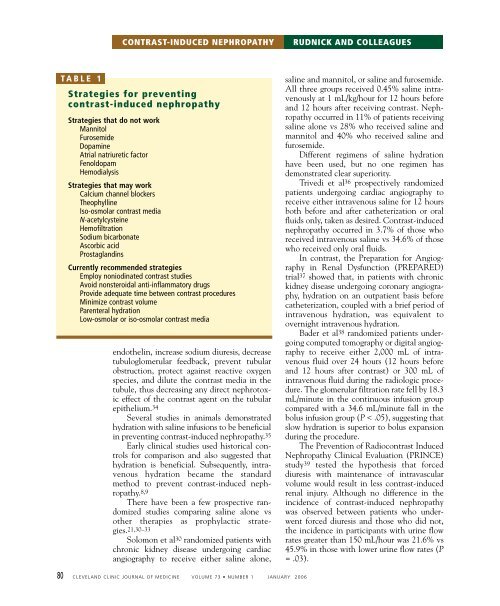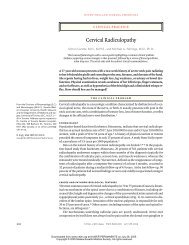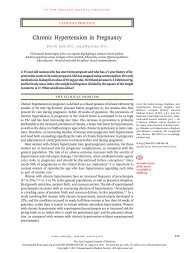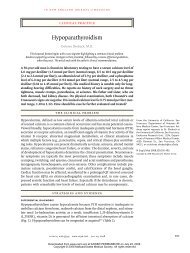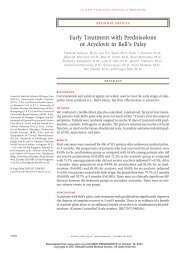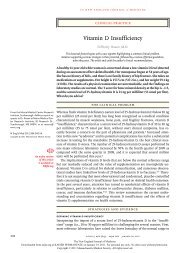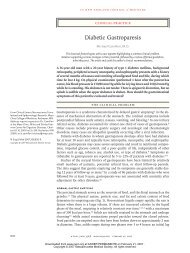Contrast-induced nephropathy: How it develops, how to prevent it
Contrast-induced nephropathy: How it develops, how to prevent it
Contrast-induced nephropathy: How it develops, how to prevent it
You also want an ePaper? Increase the reach of your titles
YUMPU automatically turns print PDFs into web optimized ePapers that Google loves.
CONTRAST-INDUCED NEPHROPATHY<br />
RUDNICK AND COLLEAGUES<br />
TABLE 1<br />
Strategies for <strong>prevent</strong>ing<br />
contrast-<strong>induced</strong> <strong>nephropathy</strong><br />
Strategies that do not work<br />
Mann<strong>it</strong>ol<br />
Furosemide<br />
Dopamine<br />
Atrial natriuretic fac<strong>to</strong>r<br />
Fenoldopam<br />
Hemodialysis<br />
Strategies that may work<br />
Calcium channel blockers<br />
Theophylline<br />
Iso-osmolar contrast media<br />
N-acetylcysteine<br />
Hemofiltration<br />
Sodium bicarbonate<br />
Ascorbic acid<br />
Prostaglandins<br />
Currently recommended strategies<br />
Employ noniodinated contrast studies<br />
Avoid nonsteroidal anti-inflamma<strong>to</strong>ry drugs<br />
Provide adequate time between contrast procedures<br />
Minimize contrast volume<br />
Parenteral hydration<br />
Low-osmolar or iso-osmolar contrast media<br />
endothelin, increase sodium diuresis, decrease<br />
tubuloglomerular feedback, <strong>prevent</strong> tubular<br />
obstruction, protect against reactive oxygen<br />
species, and dilute the contrast media in the<br />
tubule, thus decreasing any direct nephro<strong>to</strong>xic<br />
effect of the contrast agent on the tubular<br />
ep<strong>it</strong>helium. 34<br />
Several studies in animals demonstrated<br />
hydration w<strong>it</strong>h saline infusions <strong>to</strong> be beneficial<br />
in <strong>prevent</strong>ing contrast-<strong>induced</strong> <strong>nephropathy</strong>. 35<br />
Early clinical studies used his<strong>to</strong>rical controls<br />
for comparison and also suggested that<br />
hydration is beneficial. Subsequently, intravenous<br />
hydration became the standard<br />
method <strong>to</strong> <strong>prevent</strong> contrast-<strong>induced</strong> <strong>nephropathy</strong>.<br />
8,9<br />
There have been a few prospective randomized<br />
studies comparing saline alone vs<br />
other therapies as prophylactic strategies.<br />
21,30–33<br />
Solomon et al 30 randomized patients w<strong>it</strong>h<br />
chronic kidney disease undergoing cardiac<br />
angiography <strong>to</strong> receive e<strong>it</strong>her saline alone,<br />
saline and mann<strong>it</strong>ol, or saline and furosemide.<br />
All three groups received 0.45% saline intravenously<br />
at 1 mL/kg/hour for 12 hours before<br />
and 12 hours after receiving contrast. Nephropathy<br />
occurred in 11% of patients receiving<br />
saline alone vs 28% who received saline and<br />
mann<strong>it</strong>ol and 40% who received saline and<br />
furosemide.<br />
Different regimens of saline hydration<br />
have been used, but no one regimen has<br />
demonstrated clear superior<strong>it</strong>y.<br />
Trivedi et al 36 prospectively randomized<br />
patients undergoing cardiac angiography <strong>to</strong><br />
receive e<strong>it</strong>her intravenous saline for 12 hours<br />
both before and after catheterization or oral<br />
fluids only, taken as desired. <strong>Contrast</strong>-<strong>induced</strong><br />
<strong>nephropathy</strong> occurred in 3.7% of those who<br />
received intravenous saline vs 34.6% of those<br />
who received only oral fluids.<br />
In contrast, the Preparation for Angiography<br />
in Renal Dysfunction (PREPARED)<br />
trial 37 s<strong>how</strong>ed that, in patients w<strong>it</strong>h chronic<br />
kidney disease undergoing coronary angiography,<br />
hydration on an outpatient basis before<br />
catheterization, coupled w<strong>it</strong>h a brief period of<br />
intravenous hydration, was equivalent <strong>to</strong><br />
overnight intravenous hydration.<br />
Bader et al 38 randomized patients undergoing<br />
computed <strong>to</strong>mography or dig<strong>it</strong>al angiography<br />
<strong>to</strong> receive e<strong>it</strong>her 2,000 mL of intravenous<br />
fluid over 24 hours (12 hours before<br />
and 12 hours after contrast) or 300 mL of<br />
intravenous fluid during the radiologic procedure.<br />
The glomerular filtration rate fell by 18.3<br />
mL/minute in the continuous infusion group<br />
compared w<strong>it</strong>h a 34.6 mL/minute fall in the<br />
bolus infusion group (P < .05), suggesting that<br />
slow hydration is superior <strong>to</strong> bolus expansion<br />
during the procedure.<br />
The Prevention of Radiocontrast Induced<br />
Nephropathy Clinical Evaluation (PRINCE)<br />
study 39 tested the hypothesis that forced<br />
diuresis w<strong>it</strong>h maintenance of intravascular<br />
volume would result in less contrast-<strong>induced</strong><br />
renal injury. Although no difference in the<br />
incidence of contrast-<strong>induced</strong> <strong>nephropathy</strong><br />
was observed between patients who underwent<br />
forced diuresis and those who did not,<br />
the incidence in participants w<strong>it</strong>h urine flow<br />
rates greater than 150 mL/hour was 21.6% vs<br />
45.9% in those w<strong>it</strong>h lower urine flow rates (P<br />
= .03).<br />
80 CLEVELAND CLINIC JOURNAL OF MEDICINE VOLUME 73 • NUMBER 1 JANUARY 2006


